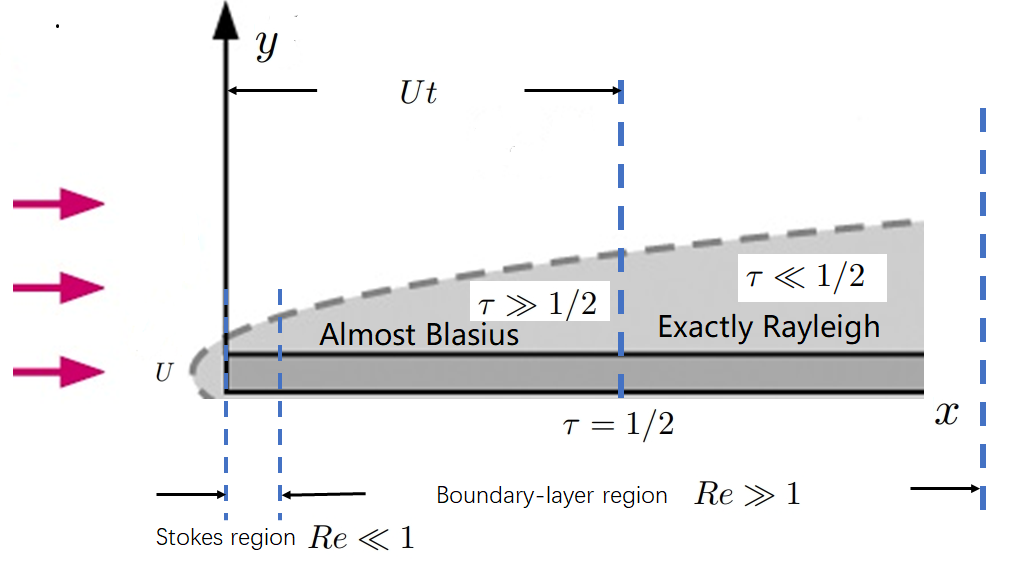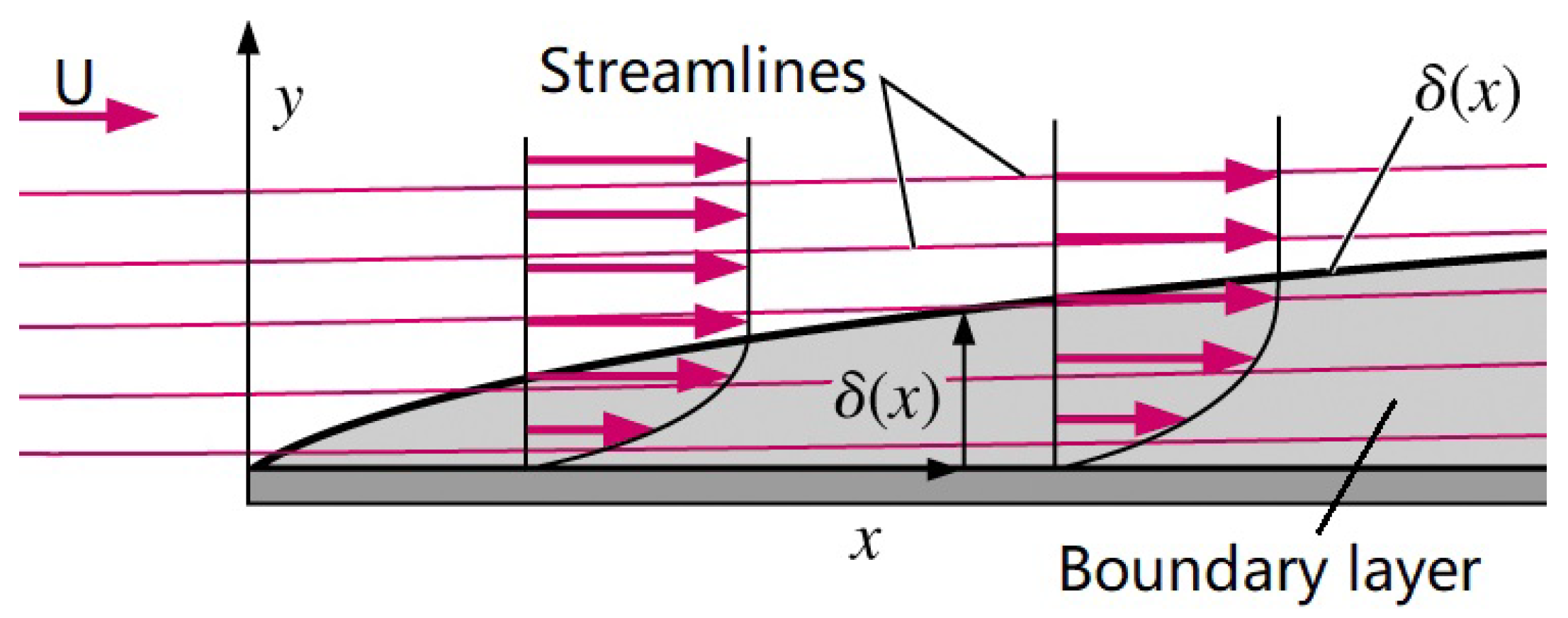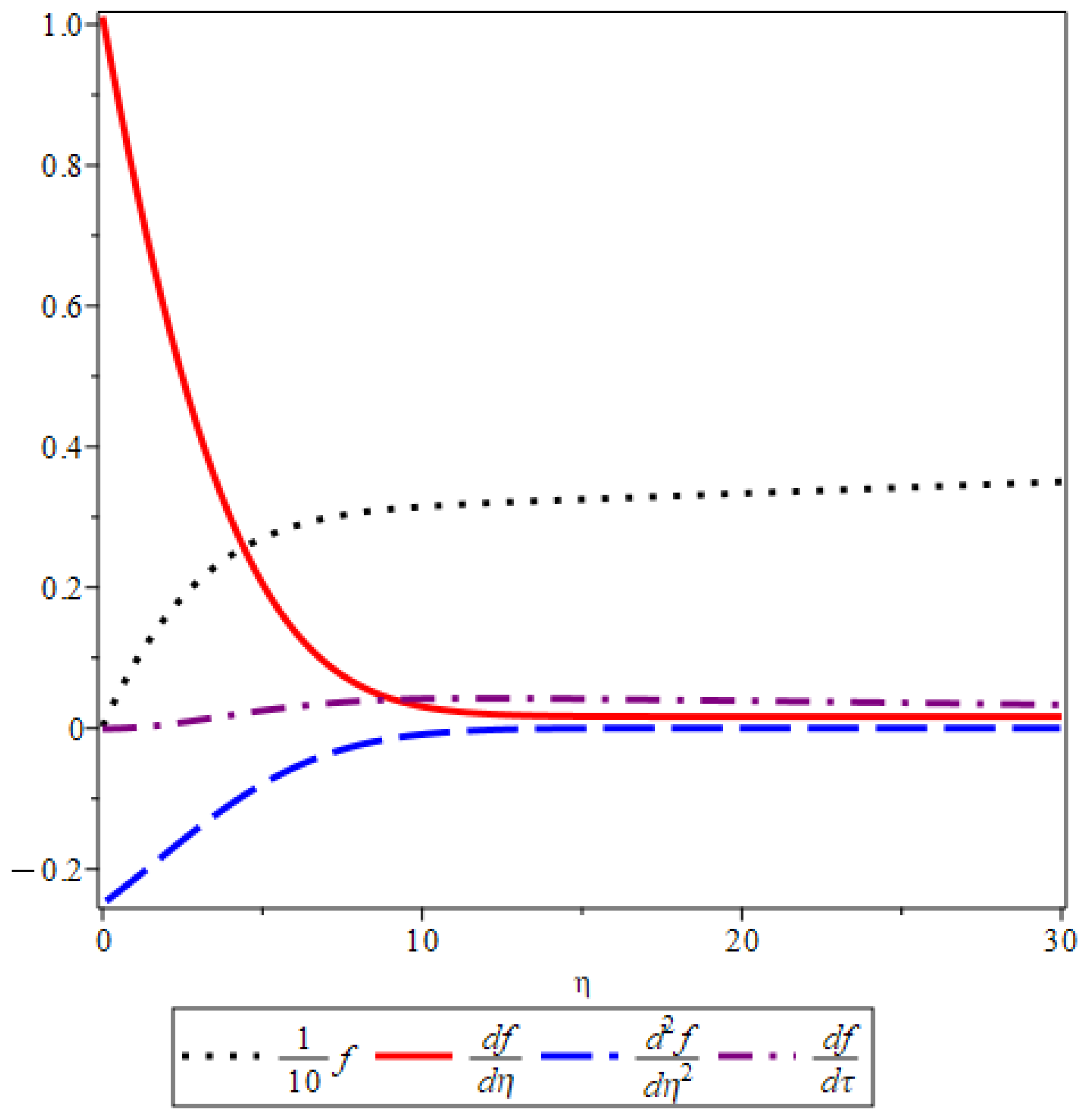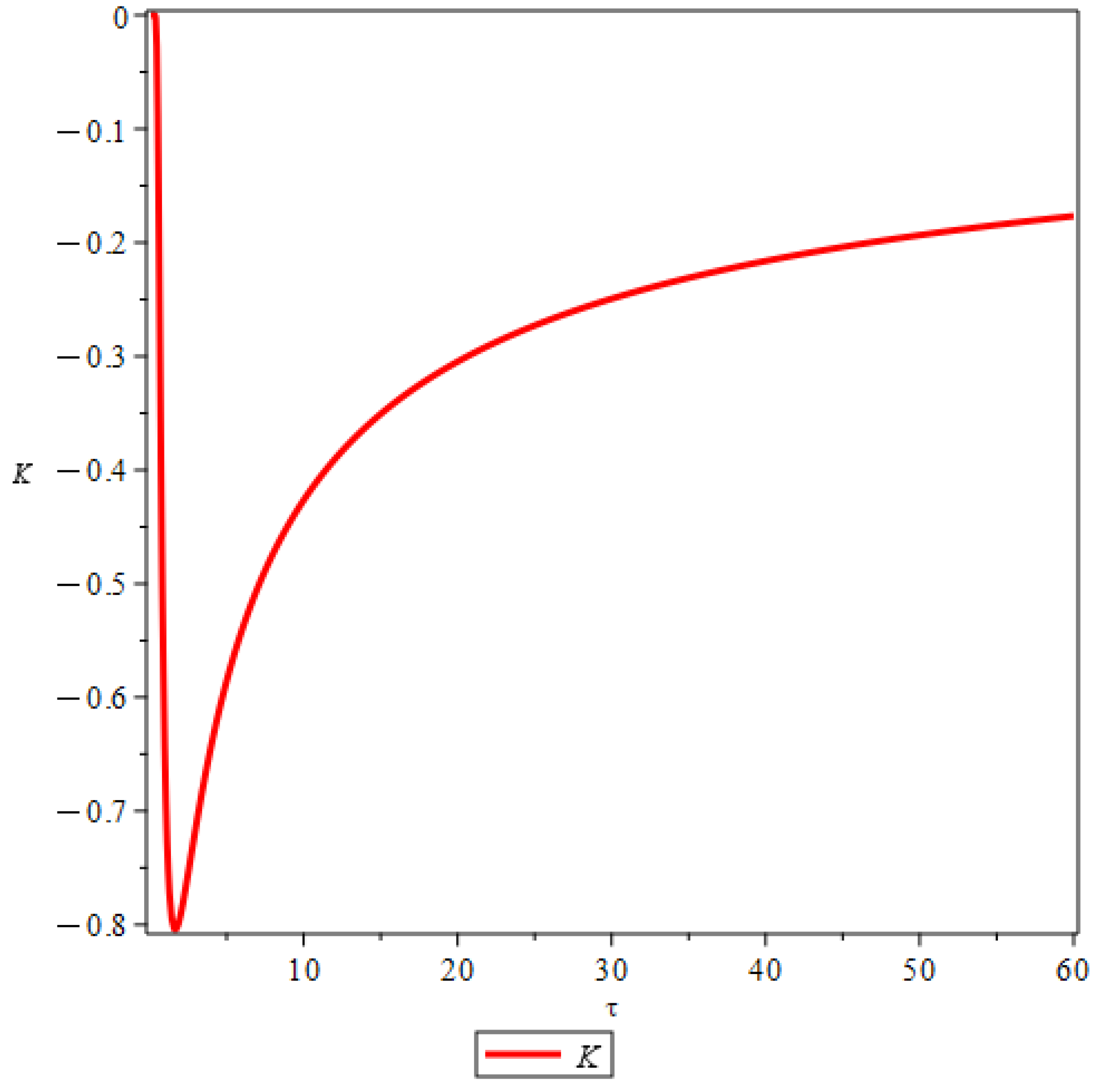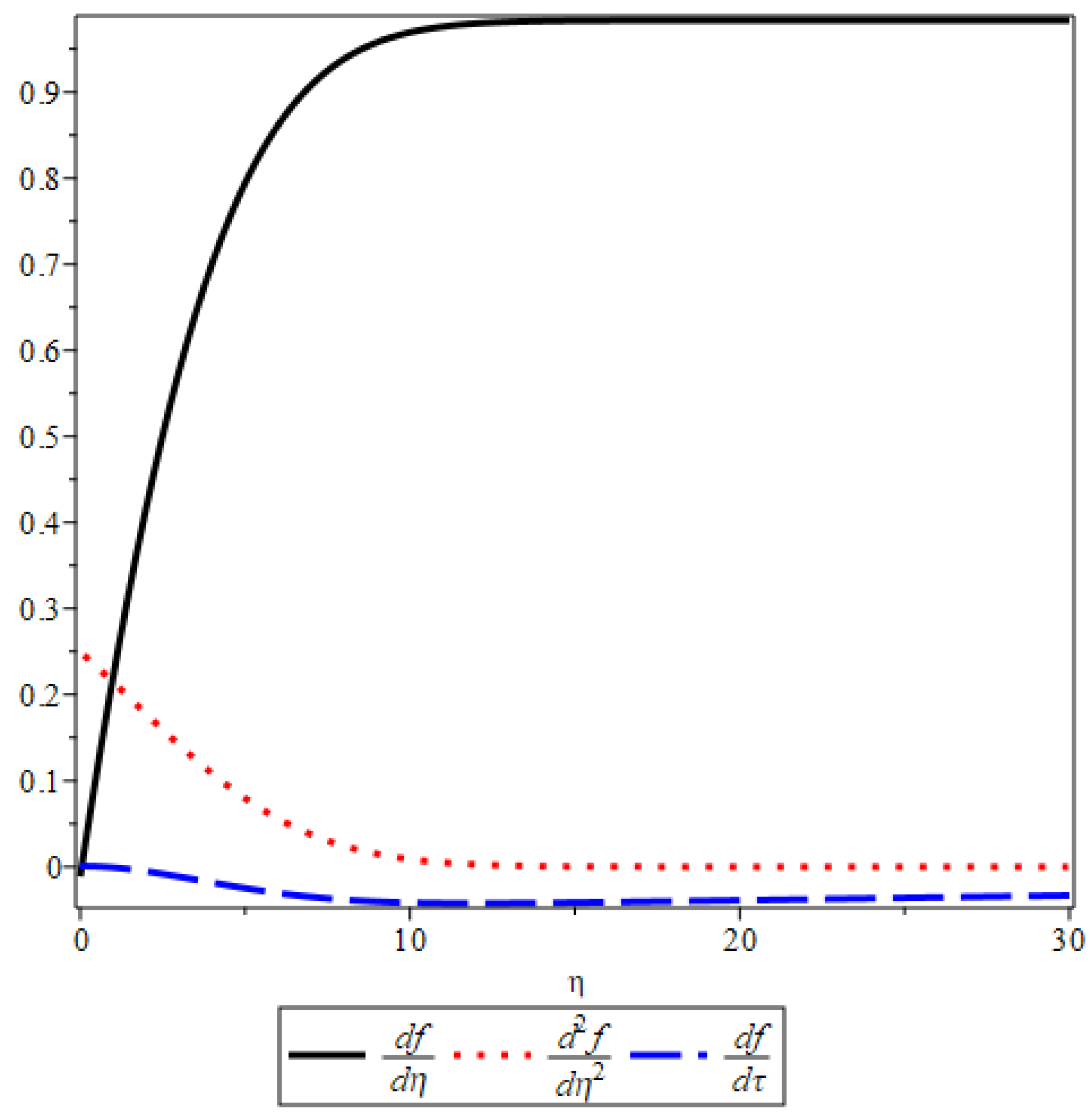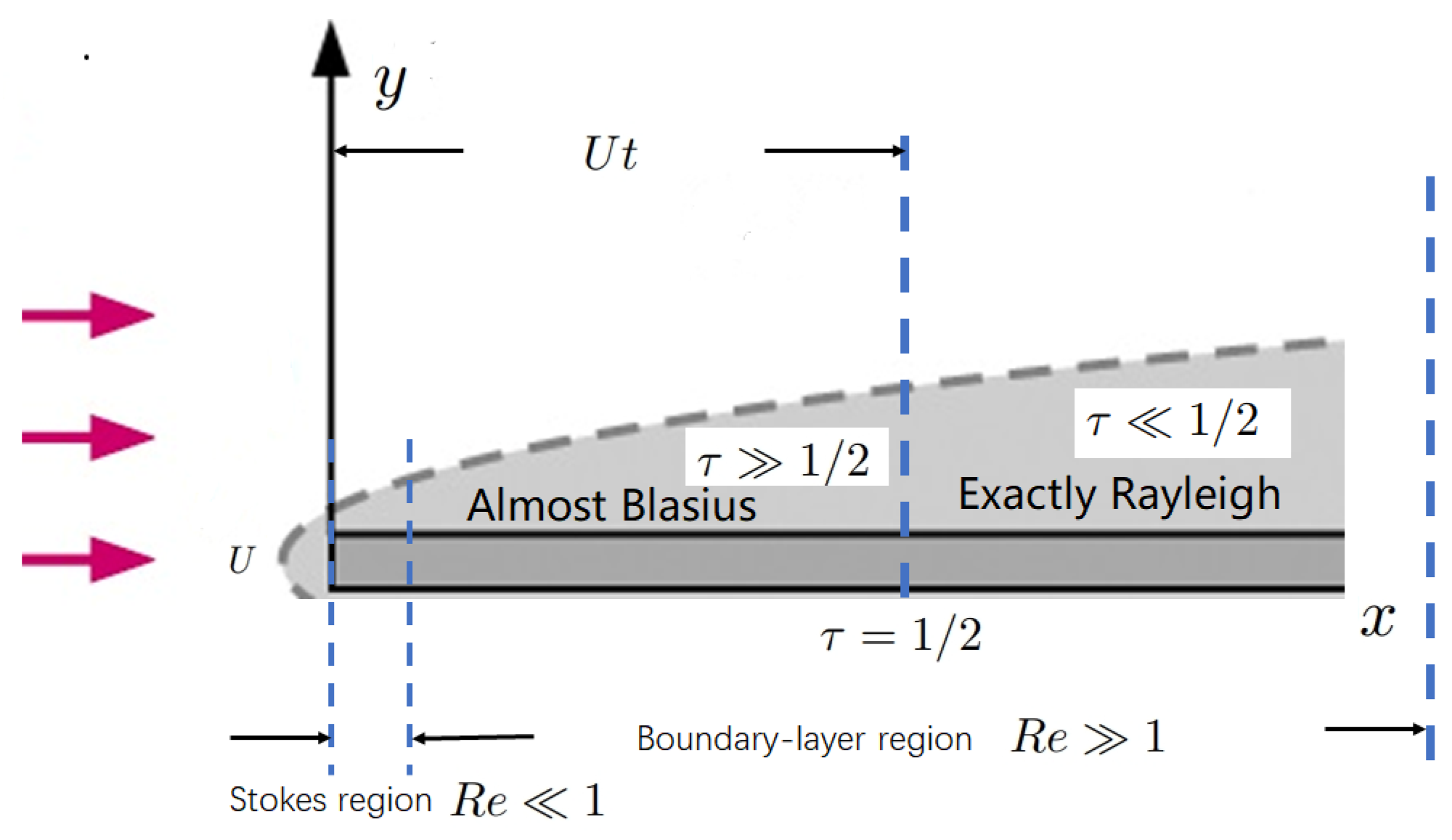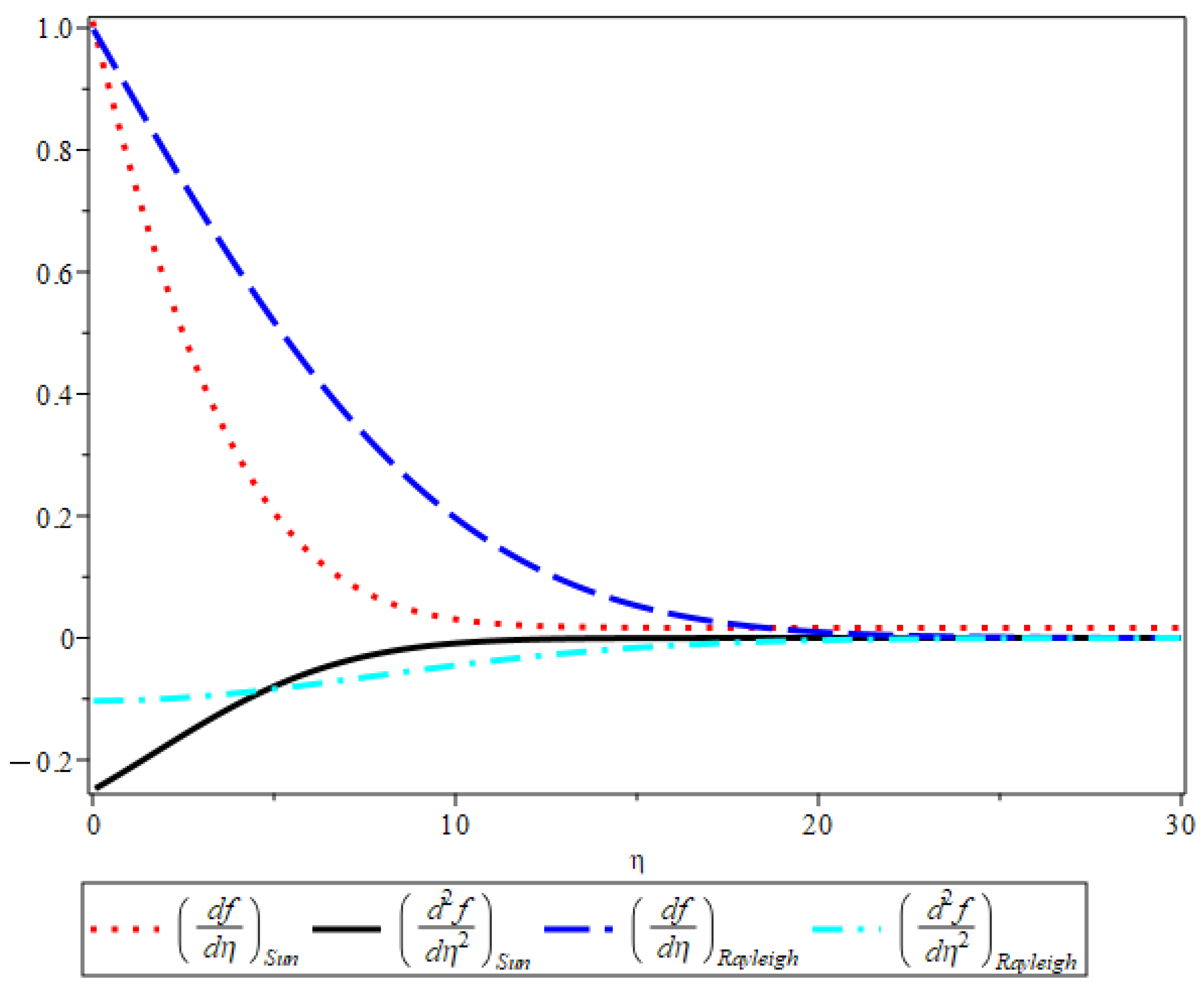1. Introduction
The study of unsteady flows is crucial for understanding the dynamics of laminar-turbulence transition [
1,
2,
3,
4,
5,
6,
7,
8,
9,
10,
11,
12,
13,
14,
15,
16,
17], and even for origin of turbulence phenomenon [
18,
19,
20,
21,
22,
23,
24,
25,
26,
27,
28,
29,
30,
31,
32,
33,
34,
35,
36,
37,
38,
39].
The Navier-Stokes equations, which govern fluid flow, are highly complex and pose significant challenges in obtaining exact solutions. Only a few one-dimensional non-steady problems have been able to achieve exact solutions [
1,
2], such as Stokes’ problem and the flow due to an oscillating infinite plane. The latter was the first exact solution in fluid dynamics [
1]. The second example of an exact solution is being the well-known Rayleigh solution for an infinite flat plate [
2], which involves an infinite flat plate impulsively started into motion in its own plane with a velocity of
. The solution to this problem is given by the equation
, where erfc is the complementary error function.
If
x is the distance along the plate measured from the leading edge and
, the motion for small
is described by the solution of Rayleigh (1911) [
1], while as
the ultimate steady-state solution is that given by Blasius (1908) [
18]. The problem of describing the transition from the one regiḿe to the other has proved to be a difficult one. It was firstly studied by Stewartson (1951) [
4], who obtained approximate solutions by making simplifications of the boundary-layer equations. In particular, Stewartson investigated the nature of the solution near
and as
. He found an essential singularity at
such that the solution for
is not an analytic continuation of the solution for
, although all derivatives with respect to
x are continuous at
. As
, the decay to the steady-state Blasius solution was found to be exponential in type, with the departure from the steady solution ultimately concentrated near the plate [
10].
A question is how the initial Rayleigh solution [
2] having no x-dependence could possibly settle down to the x-dependent but time-independent Blasius solution [
18]. Stewartson [
4]) was the first to attempt a plausible explanation for it. From the physical requirement, the Rayleigh flow must shift to an x-dependent Blasius-type flow in a smooth manner. Stewartson argued then that, in the light of no analytical development from Rayleigh- to Blasius-type flows, the smooth transition can only be possible through an essential singularity. Rather intuitively Stewartson considers
as the location of this singularity. It is argued that, for
, since a disturbance at the leading edge has not arrived yet, the flow remains of Rayleigh type; however, at
, the leading-edge effect is felt suddenly and the flow starts to have x-dependence by means of an essential singularity.? The attempt to construct the mathematical evidence for the existence of such a singularity was made by Stewartson for a flat plate. Takuda [
8] proposed a small-time solution in powers of the time, shown a smooth transition from the initial Rayleigh flow to the final Blasius flow without an essential singularity with .
In spite of the these achievements on the subject in the past, the problem still remains intriguing and confusing. The essential difficulty is to describe the transition from the Rayleigh state to the Blasius state owing to no complete solution to the problem has yet been obtained [
4]. Unfortunately, to date, no exact solutions have been obtained for the unsteady boundary layer that we are considering. As a result, we are left with no choice but to confront this challenge and strive to find new ideas and approaches to explore new frontiers in understanding unsteady flows.
In summary, just after the establishment of the Navier-Stokes equations in 1951, Stokes himself studied two non-steady fluid mechanics problems, known as Stokes’ first problem (later referred to as the Rayleigh problem) and Stokes’ 2nd problem. Both of these problems are one-dimensional, and there were no results for two-dimensional problems due to their complexity until Stewartson [
4] studied two-dimensional unsteady laminar boundary layers in 1951. Afterwards, Takuda (1968) [
8], Dennis (1972), and others attempted to study these problems, but unfortunately, none of them obtained satisfactory results. Dennis (1972) [
10] pointed out that the reason was the lack of complete analytical solutions. Due to the absence of analytical solutions, Stewartson [
4] believed that a singularity must be encountered when transition from the Rayleigh solution to the Blasius solution. This singularity conjecture remains unsolved to this day. In particular, the similar transformation introduced by Stewartson [
4] only applies to planar flows, where
constant. For flow phenomena such as contracting flow, wedge and stagnation flows, a unified similar transformation has yet to be obtained. This article solves this century-old problem in fluid mechanics entirely. Firstly, we introduce a similarity transformation that can handle different flows,
. Secondly, for
, we obtain the exact solution for the first time. Thirdly, we fully explain how the Rayleigh solution transforms into the Blasius solution. Lastly, we prove that Stewartson’s conjecture is invalid and that there is no singularity.
After introduction in
Section 1, the rest of this paper is organized as follows. In
Section 2, we formulate the 2D turbulent boundary layers and introduce a similar transformation. Under special conditions, the partial differential equations of the 2D turbulent boundary layers can be reduced to a single partial differential equation. In
Section 3, A semi-infinite flat plate impulsively started with velocity is studied, whose exact solution is obtained for the first time. In
Section 4, A semi-infinite flat plate in an uniform flow with velocity is studied, whose exact solution is obtained for the first time. In
Section 5, An open problem of from Rayleigh solution to Blasius solution is discussed. Finally, in
Section 6, conclusions are drawn.
2. Similar transformations of 2D laminar boundary layers equations
A thin flat plate is immersed at zero incidence in a uniform stream as shown in
Figure 1, which flows with speed
and is assumed not to be affected by the presence of the plate, except in the boundary layer. The fluid is supposed unlimited in extent, and the origin of coordinates is taken at the leading edge, with
x measured downstream along the plate and
y perpendicular to it.
The unsteady Navier-Stokes equations of the two dimensional boundary layers flow under gradient,
, are reduced to
and initial-boundary conditions together with initial conditions at
. In which,
is the kinematic viscosity,
is flow density,
p is pressure,
is outer of boundary layer potential flow velocity. The pressure gradient must be negative, namely
, to maintain the flow motion. For a curved boundary layers, the coordinates
should be replaced by
, where
s is arc length and
n is normal to the curve layers.
Integration of Eq.2 yields
, where
is a function of
x only [
13], then
. From Bernoulli equation, we have relation:
, leads to
. The boundary equations are reduced to following:
Introducing a stream function
and express the velocity components as follows
with the relation in Eq.
6, the mass conservation Eq.
4 is satisfied, and the momentum conservation Eq.(5) becomes
and corresponding boundary conditions.
We can assume that the velocity profiles at different distances from the leading edge are affine or similarity to one another, i.e. that the velocity profile u at different distances x can be mapped onto each other by suitable choice of scaling factors for u and y. A suitable scaling factor for u could be the free stream velocity , while for y, "boundary-layer thickness" , which increases with distance x, could be used. The similarity law of the velocity profile can thus be written as with .
Regarding the similarity of time
t, it is known that the time for any bulk property of the fluid, such as vorticity or momentum, to diffuse through a distance
is of the order of
(the "diffusion time" proposed by Stuart [
7]), hence, we can introduce a dimensionless time as
.
Based on the above understanding, introducing following transformations
where the dimensionless time transformation in Eq.10 is the key of success to solve the 2D unsteady laminar boundary layer flows and is introduced firstly in this paper.
To formulate the Eq.
7 in terms of
, we need to calculate some derivatives of function
respect to both
x and
y, for simplification, we denote
and
and so on. Noting the
and
, and by the chain rule for derivatives, we can obtain some useful relations as follows:
Thus the velocity components become
Substituting Eqs.13-18 into Eq.(
7), we have a single partial differential equation as follows
where the coefficients are
,
, and
.
If the coefficient
,
and
were constants, the Eq.
19 is solvable because it will get rid of the variable
x. Following from the relation
, its integration leads to
, canceling out
by
, we have
, hence when
, the general solution of this equation is of the form:
where the exponent
. In the same way, we have
, leads to a relation
, namely
. It implies that
is constant if both
and
were constants. Regarding the solution of Eq.
19, for constants
and
, Eq.
19 can be numerically solved.
It can be clearly seen that the Eq.
19 does not explicitly contain the coordinate
x, indicating that we have successfully transformed the original partial differential equation Eq.
7 with three independent variables
into a partial differential equation with two similar variables
. This not only facilitates solving the equation but also allows us to express the obtained results as a single profile in terms of the similar variable
. The solution with a single profile at a certain moment
t is called as the exact solution according to the arguments of Wang [
14]. In particular, although scholars such as Stewaetson [
4] and Dennis [
10] have also obtained transformed equations by introducing their similar variables, they failed to obtain exact solutions due to inappropriate similar transformations. In other words, an inappropriate similar transformation does not necessarily result in a well-structured transformed equation. Therefore, the similar transformations we introduced in Eq.
8 are of essential importance for solving the flat boundary layer problem.
3. A semi-infinite flat plate impulsively started with velocity
As an application of our formulation in previous section. Let’s consider the Stokes’ first problem [
1], Stokes’ first problem is a fundamental unsteady fluid problem from which an exact solution has been found for its one dimensional case. Here we discuss the Stokes’ first problem of 2D laminar flow.
An semi-infinitely flat plate is immersed in a viscous and stationary fluid. At
, the plate suddenly accelerates in its own plane to a velocity
, and then continues to move at a constant speed
. At the moment of initiation, the fluid surrounding the plate remains stationary due to viscosity. As time passes, the fluid near the plate gradually starts to move layer by layer due to the effect of viscosity. Clearly, this is an unsteady two-dimensional flow. This problem was first proposed by Stokes in 1851, known as Stokes’ first problem [
1], and its 1D similar solution is called the Rayleigh solution [
2].
The problem is to find the motion of a viscous fluid past a semi-infinite flat plate which, at time
, is suddenly set in motion with constant velocity
parallel to itself. This problem first attracted the attention of Stewartson [
4]. The equations governing the boundary layer flow are Eq.
1, Eq.2 and Eq.3 with
(constant), together with the initial-boundary conditions:
In the case of two dimensional plate boundary layers, if then we have , flow velocity . Since can be any real number, without loss of generality, we set , hence . The boundary thickness is .
The stream function is of the form
where
, and diffusion time
.
The Eq.
19 can be reduced to the following:
With the help of Maple [
41], we can find an exact solution of Eq.
24 as follows
where
are integral constants, the functions
and
are given in the Appendix 1.
In the following, all flow velocity and stress field calculations are based on solution
. Hence, we have the flow velocity components
To complete the calculations in the above relations, we need to have
and
.
where the functions
and
are given in the Appendix 1.
Applying the boundary conditions to the solutions in
u and
v, the function
must satisfies the following conditions
which leads to
and
which leads to following conditions
Since undefined, to make be defined, we must have . The condition in Eq.35 is satisfied due to the fact of . To find the constant , we set condition , leads to .
For any value of
, when
, we always have
. If applying the conditions in both Eq.
31 and Eq.
34 to
, We will obtain completely contradictory results. It means that these two conditions in Eq.
31 and Eq.
34 cannot be satisfied simultaneously.
The concept of
approaching infinity in in both Eq.
31 and Eq.
34 only holds mathematical significance and cannot be practically calculated in real-life calculations, because it is already outside the boundary layer when
. The conditions in Eq.
34 and Eq.35 must be satisfied firstly since they are more important than the condition Eq.
34, namely
. As a result, we obtain the following integral constants:
With the above integral constants, we can prove that the condition Eq.
31 is also satisfied due to the rapid decay ability of
. This means that the above integral constants in Eq.
36 can make the solution satisfying all solution conditions.
The function
, its derivatives
,
and
are depicted in
Figure 2.
The shear stress
where
and wall shear stress
where
Clearly, the wall shear stress is a function of , which is similar to the laminar boundary layer but totally different from 1D the planer turbulent flow, whose the wall shear stress is assumed a constant.
The skin-friction coefficient with the reference velocity
is given by
where the Reynolds number is defined as
. The dimensionless
is depicted in
Figure 3.
5. From Rayleigh solution to Blasius solution
After solving Eq.
24, let’s take a look at the transitional problem from Rayleigh solution [
2] to Blasius solution [
18] proposed by Stewartson [
4].
Introducing a new variable
, then
, the Eq.
24 can be converted into
It is not difficult to see that when
, namely
, the Eq.
48 and/or Eq.
24 becomes
, which is the Blasius equation [
18]. This means that the Blasius solution is contained in Eq.
24. Another question is whether Eq.
24 also contains the Rayleigh solution [
2]. If the Rayleigh solution is not a solution of Eq.
24, then the transitional problem from Rayleigh solution to Blasius solution proposed by Stewartson [
4] would be meaningless. If the Rayleigh solution [
2] is a solution of Eq.
24, then it answers the challenging question raised by Stewartson [
4].
From
Figure 5, for Rayleigh state, since
, Eq.
24 can be reduced to
, and can be further approximated as
, whose solution can be easily obtained as follows
together with relations
and
.
The solution in Eq.
49 satisfies Eq.
24 and all corresponding boundary conditions:
and
, therefore the solution in Eq.
49 is also an exact solution of Eq.
24.
The flow velocity components are given by
From the velocity components, we can identify the solution in Eq.?? must be the Rayleigh solution of flat plate due to impulsive motion along the direction of its plane.
Based on the discussions here, the equation Eq.
24 we derived indeed includes both Rayleigh and Blasius solutions, and their transformation is natural, without the need for the singularity assistance mentioned by Stew. In particular, in the general case, we obtain two exact solutions, which are continuous with respect to spatial coordinates and time, without any singularities. This resolves the mathematical problem proposed by Stew in 1951, which has remained unsolved for over 70 years.
Comparing the solutions in this article with Rayleigh’s solution as shown in
Figure 6, it can be observed that the decay rate of the solution in this article is much faster as
increases. The reason behind this is that the decay rate of
is much faster than
.
